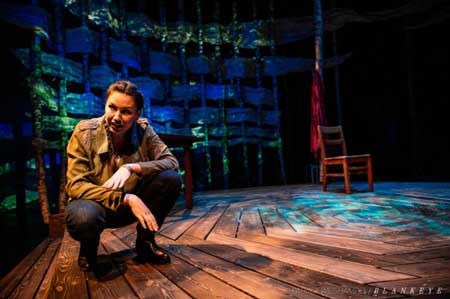Play (2017)
An Artist’s Journey Along The Trail of Tears
Written and performed by DeLanna Studi
Directed by Corey Madden
Produced by Octopus Theatricals
ArtsEmerson
Emerson Paramount Center
Washington Street, Theater District, Boston
April 26-30, 2023
Octopus Theatricals: Mara Isaacs, Executive/Creative Producer
Scenic Design: Leah Casey; Costume Design: Andja Budincich; Projections and Lighting Design: Norman Coates; Sound Design and Original Music: Bruno Louchouarn, with John-John Grant and Sarah Elizabeth Burkey

in “And So We Walked”
Photo: Patrick Weishampel
Courtesy of ArtsEmerson and Octopus Theatricals
At the center of this very full two hour single-woman show is a return of the protagonist based seemingly almost completely on the life and experience of the author and the performer of this show, DeLanna Studi, to the Trail of Tears, the route 17,000 Cherokees were forced to travel under duress in the 1830s when expelled from their lands. That route stretched from North Carolina to Oklahoma, and many thousands died along the way. The odyssey taken by the protagonist and her Cherokee father forms the core of this informative, interesting, partially heartbreaking and partially humorous account. Though the subject itself, the Trail of Tears, is a distinctly bleak one, Studi makes her own very personal recounting of her revisiting it enlivening and whimsical enough to give considerable buoyancy to an inherently tragic subject.
The character in the play, like Studi, is an actress born of a full-blooded Cherokee father and a mother of European extraction, who has left her home in Oklahoma to pursue opportunities in Los Angeles and New York. Drawn back home for a visit at one point, she undergoes some degree of confrontation with her father who, among other things, wants her to live closer to home. Though that is not on her agenda, she does find a path to their deep connection based on their mutual Cherokee roots, and by enlisting him, along with several other companions, to accompany her on the retracing of the 900 mile Trail of Tears from North Carolina to Oklahoma.
There is plenty of interesting history in this play, and it goes by fast, but it provides a solid anchor of the central moving theme that is embellished by a multifaceted narrative that touches on a number of personal issues and traumatic experiences. The Dawes Act of 1887, the Indian Removal Act of 1830 signed by President Andrew Jackson, the deal of a non-representative group of Cherokee leaders who sold their lands to the US government for $5 million, and the great sense of displacement and despair that followed for so many Cherokees, come forth vividly.
That important history is interlaced with a more personal narrative which incorporates details of the protagonist’s upbringing, her romantic affiliations, and her professional pursuits as an actress. As well, there is a certain amount of psychopharmacology and psychopathology that enter in, not always is a clear enough and detailed way to make coherent sense, but which give a sense of the sometimes fraught psyche confronting things. A lover named Steve shows up episodically, and there is repeated reference to a traumatic car accident, both causing the protagonist a good deal of pain.
Other illuminating bits of personal history sink in along the way. While recalling talking about the Cherokee in her elementary school as a child, the protagonist remembers that her teacher responded that American Indians were extinct! Proudly, the protagonist recalls proudly that when her father learned of this, he ran for the local school board, got elected and changed the curriculum accordingly.
At the core of the drama is the texture of this relationship between father and daughter, and the role of Cherokee identity and the historic tragedy connected with The Trail of Tears that surrounds, and in so many ways, forms them. In this sense, encounter of father and daughter along that trail, and the embellishing of history that describes it, is the satisfying substance of the play. In a personal and immediate way, it brings the history to life.
There are lots of additional characters who enter in by reference, including an anthropologist, the protagonist’s sister, as well as a tribal activist named Mavis who is challenging the Cherokee Chief’s authority, and various others who enter into the planning and execution of the retracing of the The Trail of Tears. They all add to the landscape in one way or another, but there are too many of them to make much of an impact. This diffusion of characters along with the episodic allusions to romance, acting gigs and the tragic car accident are secondary embellishments that provide less coherent narrative than does the story of the protagonist and her father.
Studi’s delivery of the story is clear and vivid and she does a great job of embodying convincingly the multiple characters as they arise. The show is quite long but she manages to keep the energy up and the story flowing throughout. This consistency of energy in performance and the attendant desire to bring forth the tragic drama of the Cherokees in the nineteenth century provide significant moments of dramatic vividness and persuasiveness and certainly offers both an emotional and informational stepping-stone into many of the details of this sad history.
– BADMan (aka Charles Munitz)
Leave a Reply